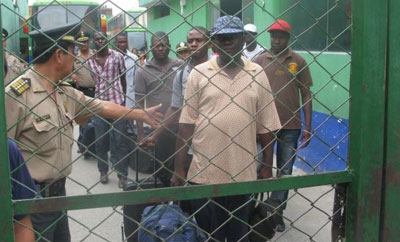Peru has announced measures to combat human smuggling networks that facilitate illegal migration from Haiti to Brazil, highlighting the country’s role in a trade that capitalizes on the desperation of people from the region’s poorest country.
On March 20, Peruvian authorities launched a campaign aimed at stopping abuses by so-called “coyotes,” who facilitate a trade that uses Peru as a stopover and has increased exponentially since Haiti’s devastating 2010 earthquake, reported TeleSUR TV.
The campaign consists of handing out 5,000 pamphlets, written in both Creole and French, at various border checkpoints, police stations and other public offices. A Haitian refugee living in Peru will also issue a radio warning to his fellow countrymen regarding the dangers of crossing illegally into the neighboring country, reported AFP.
According to Peruvian ambassador Carlos Polo Castañeda, coyotes operating in Peru charge Haitian migrants up to $5,000 to take them across the border.
Ombudsman Eduardo Vega said between 40 and 60 Haitians make the trip each day, facing numerous abuses and dangers on the 2,000 kilometer trip from the north of Peru to the crossing point of Iñapari, in the southeastern jungle region of Madre de Dios, which borders the Brazilian state of Acre.
InSight Crime Analysis
Brazil has become a major destination point for undocumented Haitian migrants. In early 2013, authorities reported over 5,000 immigrants entering the state of Acre via Peru and Bolivia over the course of just a few weeks, the majority of them originally from Haiti. In January this year, Acre authorities said they would ask the central government to shut that border with Peru in response to the “unsustainable” situation, while in 2012, the migratory flow pushed Brazil to place limits on Haitian immigration.
Peru is an important stop along the route for Haitian migrants, which often follows a Haiti-Dominican Republic-Panama-Ecuador-Peru-Brazil trajectory, according to Brazilian authorities. Peruvian officials say the coyotes usually pick the migrants up near the northern city of Tumbes.
SEE ALSO: Coverage of Human Smuggling
The Haitians are driven largely by continued hardship in the face of stumbling disaster recovery efforts, with over 15,000 migrating from their country to other parts of Latin America between 2010 and 2012. The vulnerable migrants are easy pickings for coyotes, which are also a prominent feature of Central American migrants’ attempts to reach the United States.
But with Brazil a major center for forced labor (pdf) — with more than 220,000 people reported to live in conditions of modern-day slavery — the treacherous journey could be far from over, as Haitian’s reliance on human smuggling networks puts them at risk of exploitation from human traffickers.

